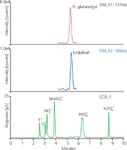Direct Determination of Endothall in Water Samples by IC–MS
The Application Notebook
Endothall is a widely used herbicide for both terrestrial and aquatic weeds. Exposure to endothall in excess of the maximum contamination level (MCL) can cause illness. Endothall is regulated by the U.S.
Leo (Jinyuan) Wang and William C. Schnute, Dionex Corporation
Endothall is a widely used herbicide for both terrestrial and aquatic weeds. Exposure to endothall in excess of the maximum contamination level (MCL) can cause illness. Endothall is regulated by the U.S. Environmental Protection Agency (EPA) at 100 ppb in drinking water, and by the California EPA at 0.58 mg/L, or 580 ppb, as the Public Health Goal. Current analytical methods described in EPA method 548.1 for the quantitation of endothall in water samples involve time-consuming sample preparation and derivatization followed by a 20-min analysis by GC–MS or GC–FID.
This study describes the direct analysis of trace levels of endothall in water samples by ion chromatography mass spectrometry (IC–MS). Water samples were directly injected for analysis and chromatographic separation was reduced to 10 min. The MSQ Plus™ Mass Spectrometer was operated in selected ion monitoring (SIM) mode, allowing minimum sample cleanup and ensuring sensitive (low ppb) and selective quantification. Isotope labeled glutaric acid (Glutarate–d6) was used as the internal standard to ensure quantitation accuracy.

Figure 1: IC-MS of 20 ppb endothall spiked in a seven anions matrix: 0.2â1.5 ppm.
Experimental Conditions
System: Dionex ICS-5000 RFIC System
Column: IonPac® AS16 and AG16 (2 mm)
Temp.: 30 °C
Flow Rate: 400 µL/min
Mobile Phase: Hydroxide gradient generated from EG-II KOH cartridge (15 mM hydroxide after 4 min equilibration; ramp to 80 mM from 5 to 6 min and held for 3 min; return to initial condition in 0.5 min)
Detection: Suppressed conductivity and MSQ Plus mass spectrometer
Ionization Source: Electrospray ionization (ESI)
Probe Temp.: 500 °C
Needle Voltage: 3000 V
Solvent: 200 µL/min acetonitrile delivered by an AXP-MS pump
Matrix Diversion: Eluent to MS: 4.2 – 6 min
Acquisition Mode: Selected ion monitoring (SIM)
Analyte: SIM (m/z)
Endothall: 185 at 50V
IS (glutarate-d6): 137 at 35V
Results and Conclusion
As seen in Figure 1, endothall was retained and separated from seven commonly seen anions within 10 min, and was detected with great sensitivity and selectivity using SIM acquisition. This method features direct analysis without sample pretreatment and significantly reduces run time relative to GC methods, thus improving throughput. Sufficient sensitivity was achieved in this study to allow the routine quantification of endothall below the lowest regulated level (100 ppb by U.S. EPA standards).
IonPac is a registered trademark of Dionex Corporation. MSQ Plus is a trademark of Thermo Fisher Scientific.
Dionex Corporation
1228 Titan Way, P.O. Box 3603, Sunnyvale, CA 94088
tel. (408) 737-0700, fax (408) 730-9403
Website: www.dionex.com

Distinguishing Alcohol- from Non-Alcohol-Associated Liver Cirrhosis with LC-MS
May 7th 2025A pilot study investigating whether nicotinamide adenine dinucleotide kinase (NADK) expression is selectively diminished in alcohol-associated liver cirrhosis (AC), as well as evaluating its potential as a biomarker for this condition, measured AC and non-AC (NAC). Nicotinamide adenine dinucleotide (NAD+) and nicotinamide adenine dinucleotide phosphate (NADP+) levels in human liver samples were measured using liquid chromatography-mass spectrometry (LC-MS).

.png&w=3840&q=75)

.png&w=3840&q=75)



.png&w=3840&q=75)



.png&w=3840&q=75)


















